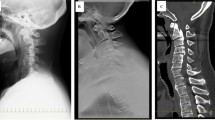Abstract
Background
Lumbar spondylolysis, a unilateral or bilateral fracture at pars interarticularis, is a common cause of low back pain in children. The initial imaging study in the diagnosis of lumbar spondylolysis has historically been lumbar spine radiographs; however, radiographs can be equivocal or false-negative. Definitive diagnosis can be achieved with computed tomography (CT), but its use has been limited due to the dose of ionizing radiation to the patient.
Objective
By limiting the z-axis coverage to the relevant anatomy and optimizing the CT protocol, we are able to provide a definitive diagnosis of fractures of the pars interarticularis at comparable or lower radiation dose than commonly performed lumbar spine radiographs. As there is no gold standard for the diagnosis of spondylolysis besides surgery, we compared interobserver agreement and degree of confidence to determine which modality is preferable.
Materials and methods
Sixty-two patients with low back pain ages 5-18 years were assessed for the presence of spondylolyis. Forty-seven patients were evaluated by radiography and 15 patients were evaluated by limited field-of-view CT. Both radiographic and CT examinations were assessed anonymously in random order for the presence or absence of spondylolyisis by six raters. Agreement was assessed among raters using a Fleiss Kappa statistic for multiple raters.
Results
CT provided a significantly higher level of agreement among raters than radiographs (P < 0.001). The overall Kappa for rater agreement with radiographs was 0.24, 0.34 and 0.40 for 2, 3 or 4 views, respectively, and 0.88 with CT.
Conclusion
Interobserver agreement is significantly greater using limited z-axis coverage CT when compared with radiographs. Radiologist confidence improved significantly with CT compared to radiographs regardless of the number of views.


Similar content being viewed by others
References
Turner PG, Green JH, Galasko CS (1989) Back pain in childhood. Spine (Phila Pa 1976) 14:812–814
Leone A, Cianfoni A, Cerase A et al (2011) Lumbar spondylolysis: a review. Skeletal Radiol 40:683–700
Fredrickson BE, Baker D, McHolick WJ et al (1984) The natural history of spondylolysis and spondylolisthesis. J Bone Joint Surg Am 66:699–707
Amato M, Totty WG, Gilula LA (1984) Spondylolysis of the lumbar spine: demonstration of defects and laminal fragmentation. Radiology 153:627–629
Harvey CJ, Richenberg JL, Saifuddin A (1998) The radiological investigation of lumbar spondylolysis. Clin Radiol 53:723–728
Saifuddin A, White J, Tucker S et al (1998) Orientation of lumbar pars defects: implications for radiological detection and surgical management. J Bone Joint Surg Br 80:208–211
Dunn AJ, Campbell RS, Mayor PE et al (2008) Radiological findings and healing patterns of incomplete stress fractures of the pars interarticularis. Skeletal Radiol 37:443–450
Campbell RS, Grainger AJ, Hide IG et al (2005) Juvenile spondylolysis: a comparative analysis of CT, SPECT and MRI. Skeletal Radiol 34:63–73
Fleiss JL (2003) Statistical methods for rates and proportions. Wiley, New York
Landis JR, Koch GG (1977) The measurement of observer agreement for categorical data. Biometrics 33:159–174
AAPM Task Group 23 (2008) The Measurement, reporting and management of radiation dose in CT. AAPM Report No 96. American Association of Physicists in Medicine (AAPM), College Park
European Study Group (2000) European guidelines on quality criteria for computed tomography. In: Menzel H, Schibilla H, Teunen D (eds) European Commission. European Commission’s Radiation Protection Actions, Luxembourg
AAPM Task Group 204 (2011) Size-specific dose estimates (SSDE) in pediatric and adult body CT examinations. AAPM Report No 204. American Association of Physicists in Medicine (AAPM), College Park
Teplick JG, Laffey PA, Berman A et al (1986) Diagnosis and evaluation of spondylolisthesis and/or spondylolysis on axial CT. AJNR Am J Neuroradiol 7:479–491
Vorona GA, Ceschin RC, Clayton BL et al (2011) Reducing abdominal CT radiation dose with the adaptive statistical iterative reconstruction technique in children: a feasibility study. Pediatr Radiol 41:1174–1182
Conflicts of interest
None
Author information
Authors and Affiliations
Corresponding author
Rights and permissions
About this article
Cite this article
Fadell, M.F., Gralla, J., Bercha, I. et al. CT outperforms radiographs at a comparable radiation dose in the assessment for spondylolysis. Pediatr Radiol 45, 1026–1030 (2015). https://doi.org/10.1007/s00247-015-3278-z
Received:
Revised:
Accepted:
Published:
Issue Date:
DOI: https://doi.org/10.1007/s00247-015-3278-z




